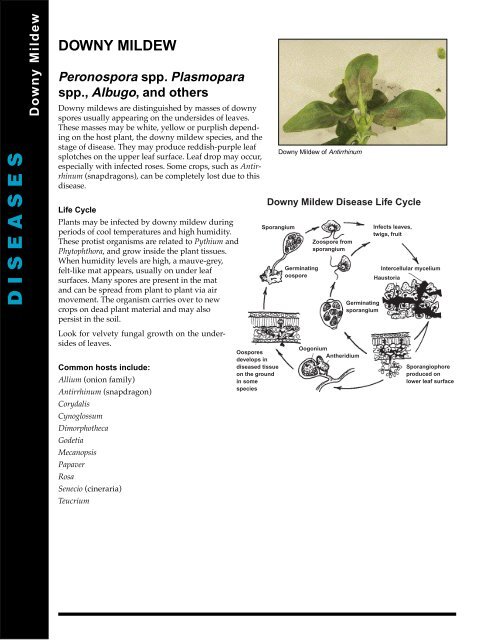Downy Mildew - BC Ministry of Agriculture, Food and Fisheries
Downy Mildew - BC Ministry of Agriculture, Food and Fisheries
Downy Mildew - BC Ministry of Agriculture, Food and Fisheries
You also want an ePaper? Increase the reach of your titles
YUMPU automatically turns print PDFs into web optimized ePapers that Google loves.
D I S E A S E S<br />
<strong>Downy</strong> <strong>Mildew</strong><br />
DOWNY MILDEW<br />
Peronospora spp. Plasmopara<br />
spp., Albugo, <strong>and</strong> others<br />
<strong>Downy</strong> mildews are distinguished by masses <strong>of</strong> downy<br />
spores usually appearing on the undersides <strong>of</strong> leaves.<br />
These masses may be white, yellow or purplish depending<br />
on the host plant, the downy mildew species, <strong>and</strong> the<br />
stage <strong>of</strong> disease. They may produce reddish-purple leaf<br />
splotches on the upper leaf surface. Leaf drop may occur,<br />
especially with infected roses. Some crops, such as Antirrhinum<br />
(snapdragons), can be completely lost due to this<br />
disease.<br />
Life Cycle<br />
Plants may be infected by downy mildew during<br />
periods <strong>of</strong> cool temperatures <strong>and</strong> high humidity.<br />
These protist organisms are related to Pythium <strong>and</strong><br />
Phytophthora, <strong>and</strong> grow inside the plant tissues.<br />
When humidity levels are high, a mauve-grey,<br />
felt-like mat appears, usually on under leaf<br />
surfaces. Many spores are present in the mat<br />
<strong>and</strong> can be spread from plant to plant via air<br />
movement. The organism carries over to new<br />
crops on dead plant material <strong>and</strong> may also<br />
persist in the soil.<br />
<strong>Downy</strong> <strong>Mildew</strong> <strong>of</strong> Antirrhinum<br />
<strong>Downy</strong> <strong>Mildew</strong> Disease Life Cycle<br />
Sporangium<br />
Germinating<br />
oospore<br />
Zoospore from<br />
sporangium<br />
Germinating<br />
sporangium<br />
Infects leaves,<br />
twigs, fruit<br />
Intercellular mycelium<br />
Haustoria<br />
Look for velvety fungal growth on the undersides<br />
<strong>of</strong> leaves.<br />
Common hosts include:<br />
Allium (onion family)<br />
Antirrhinum (snapdragon)<br />
Oospores<br />
develops in<br />
diseased tissue<br />
on the ground<br />
in some<br />
species<br />
Oogonium<br />
Antheridium<br />
Sporangiophore<br />
produced on<br />
lower leaf surface<br />
Corydalis<br />
Cynoglossum<br />
Dimorphotheca<br />
Godetia<br />
Mecanopsis<br />
Papaver<br />
Rosa<br />
Senecio (cineraria)<br />
Teucrium
<strong>Downy</strong> <strong>Mildew</strong><br />
Antirrhinum (Peronospora antirrhini)<br />
Infected plants are stunted. Dead or dying spots or areas<br />
appear on infected leaves. Upper leaves show yellowish<br />
discolouration. A light grey-brown, felt-like growth can be<br />
observed on the undersides <strong>of</strong> infected leaves. The growing<br />
points eventually die.<br />
D I S E A S E S<br />
Rosa (Peronospora sparsa)<br />
Purplish-red to dark brown spots form on leaves. Leaflets<br />
turn yellow with isl<strong>and</strong>s <strong>of</strong> green spots remaining. Greyish<br />
masses <strong>of</strong> spores may develop on undersides <strong>of</strong> leaves<br />
in humid conditions. Leaves may drop prematurely <strong>and</strong><br />
plants may be stunted.<br />
<strong>Downy</strong> <strong>Mildew</strong> <strong>of</strong> Antirrhinum<br />
<strong>Downy</strong> <strong>Mildew</strong> <strong>of</strong> Rosa<br />
<strong>Downy</strong> <strong>Mildew</strong> <strong>of</strong> Rosa
















